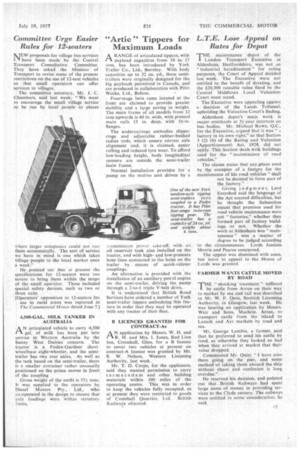"Artie" Tippers for L.T.E. Lose Appeal on Maximum Loads Rates
Page 39

If you've noticed an error in this article please click here to report it so we can fix it.
for Depot A RANGE of articulated tippers, with r-1 payload capacities from 10 to 17 tons, has been introduced by York Trailer Co., Ltd., Burnley. With body capacities up to 32 cu. yd., these semitrailers were originally designed for the big payloads permitted in Canada, and are produced in collaboration with Pilot Works, Ltd., Bolton.
Four-stage twin rams located at the front are claimed to provide greater stability and a large saving in weight. The main frame of all models from 12 tons upwards is 40 in. wide, with pressed main rails 15 in. deep, with 3+-in. flanges.
The undercarriage embodies Slipper rings and adjustable rubber-bushed radius rods, which ensure correct axle alignment and, it is claimed, easier rolling and reduced tyre wear. To afford low-loading • height, body longitudinal runners are outside the semi-trailer Main frame.
Normal installation provides for a pump on the motive unit driven by a transmission power take-off, with an. oil reservoir tank also installed on the tractor, and with highand low-pressure hose lines connected to the hoist on the trailer by means of quick-release couplings.
An alternative is provided with the installation of an auxiliary petrol engine on the semi-trailer, driving the pump through a 2-to-1 triple V-belt drive.
It is understood that British Road Services have ordered a number of York semi-trailer tippers embodying this feature in order that they may be operated with any tractor of their fleet.
B LICENCES GRANTED FOR CONTRACT-As
AN application by Messrs. W. H. and R. H. and Mrs. T. Jones, Red Lion Inn, Cromhall, Glos, for a B licence to cover two vehicles at present on contract-A licence was granted by Mr. S. W. Nelson, Western Licensing Authority, last week.
Mr. T. D. Corpe, for the applicants, said they wanted permission to carry t ar maca dam and other building materials within 100 miles of the operating centre. This was in order to keep the vehicles fully occupied, as at present they were restricted to goods of Cromhall Quarries, Ltd. British Railways objected.
THE maintenance depot of the London Transport Executive at Aldenham, Hertfordshire, was not an
"industrial hereditament for rating purposes, the Court of Appeal decided last week. The Executive were not entitled to the benefit of derating, and the £20,300 rateable value fixed by the Central Middlesex Local Valuation Court must stand.
The Executive were appealing against a decision of the Lands Tribunal, upholding the Valuation Court's finding.
Aldenham depot's main work is major overhauls at 31-year intervals on bus bodies. Mr. Michael Rowe, Q.C., for the Executive, argued that it was "a factory in its own right," so that Section 3 (2) (b) of the Rating and Valuation (Apportionment) Act, 1928, did not apply. This Section deals with buildings used for the "maintenance of road vehicles."
The clause states that any,plaee used by the occupier of a factpry for the maintenance of his road vehicles "shall not be deemed to form part of the factory."
Giving judgment, Lord Evershed said the language of the Act created difficulties, but he thought the Subsection meant that premises used for road vehicle maintenance were not "factories," whether they formed part of factory buildings or not. Whether the work at Aldenham was" maintenance" was a matter. of degree to be judged according to the circumstances. Lords Justices Morris and Pearce concurred.
The appeal was dismissed with costs, but leave to appeal to the House of Lords was granted.
FARMER WANTS CATTLE MOVED BY ROAD
THE" shocking treatment" suffered by cattle from Arran on their way to market by sea and rail was described to Mr. W. F. Quin, Scottish Licensing Authority, in Glasgow, last week. He was hearing an application by Messrs. Weir and Sons, Machrie, Arran, to ,transport cattle from the island to Lanark and Ayr markets by road and sea.
Mr. George Lambie, a farmer, said that he preferred to send his cattle by road, as otherwise they looked so bad when they arrived at market that their value dropped.
Commented Mr. Quin: "1 have seen them going on the pier, and Some method of taking them aboard the ship without chaos and confusion is long overdue."
He reserved his decision, and pointed out that British Railways had spent large sums of money in providing services to the Clyde estuary. The railways were entitled to some consideration, he said.




























































































